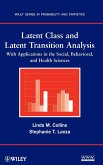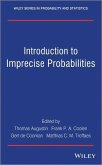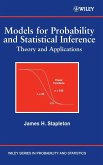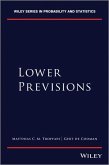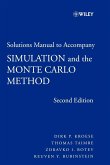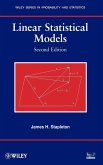- Gebundenes Buch
- Merkliste
- Auf die Merkliste
- Bewerten Bewerten
- Teilen
- Produkt teilen
- Produkterinnerung
- Produkterinnerung
With a focus on models and tangible applications of probability from physics, computer science, and other related disciplines, this book successfully guides readers through fundamental coverage for enhanced understanding of the problems. Topical coverage includes: bivariate discrete random, continuous random, and stochastic independence-multivariate random variables; transformations of random variables; covariance-correlation; multivariate distributions; the Central Limit Theorem; stochastic processes; and more. The book is ideal for a second course in probability and for researchers and professionals.…mehr
Andere Kunden interessierten sich auch für
![Latent Class Analysis Latent Class Analysis]() Linda M. CollinsLatent Class Analysis124,99 €
Linda M. CollinsLatent Class Analysis124,99 €![Introduction to Imprecise Probabilities Introduction to Imprecise Probabilities]() TT AugustinIntroduction to Imprecise Probabilities94,99 €
TT AugustinIntroduction to Imprecise Probabilities94,99 €![Models for Probability and Statistical Inference Models for Probability and Statistical Inference]() James H. StapletonModels for Probability and Statistical Inference151,99 €
James H. StapletonModels for Probability and Statistical Inference151,99 €![Statistical Inference for Fractional Diffusion Processes Statistical Inference for Fractional Diffusion Processes]() B. L. S. Prakasa RaoStatistical Inference for Fractional Diffusion Processes112,99 €
B. L. S. Prakasa RaoStatistical Inference for Fractional Diffusion Processes112,99 €![Lower Previsions Lower Previsions]() Matthias C. M. TroffaesLower Previsions86,99 €
Matthias C. M. TroffaesLower Previsions86,99 €![Student Solutions Manual to Accompany Simulation and the Monte Carlo Method Student Solutions Manual to Accompany Simulation and the Monte Carlo Method]() Dirk P. KroeseStudent Solutions Manual to Accompany Simulation and the Monte Carlo Method36,99 €
Dirk P. KroeseStudent Solutions Manual to Accompany Simulation and the Monte Carlo Method36,99 €![Linear Statistical Models 2e Linear Statistical Models 2e]() James H. StapletonLinear Statistical Models 2e138,99 €
James H. StapletonLinear Statistical Models 2e138,99 €-
-
-
With a focus on models and tangible applications of probability from physics, computer science, and other related disciplines, this book successfully guides readers through fundamental coverage for enhanced understanding of the problems. Topical coverage includes: bivariate discrete random, continuous random, and stochastic independence-multivariate random variables; transformations of random variables; covariance-correlation; multivariate distributions; the Central Limit Theorem; stochastic processes; and more. The book is ideal for a second course in probability and for researchers and professionals.
Hinweis: Dieser Artikel kann nur an eine deutsche Lieferadresse ausgeliefert werden.
Hinweis: Dieser Artikel kann nur an eine deutsche Lieferadresse ausgeliefert werden.
Produktdetails
- Produktdetails
- Wiley Series in Probability and Statistics
- Verlag: Wiley & Sons
- 1. Auflage
- Seitenzahl: 624
- Erscheinungstermin: 7. Mai 2019
- Englisch
- Abmessung: 252mm x 184mm x 37mm
- Gewicht: 1501g
- ISBN-13: 9781118123348
- ISBN-10: 1118123344
- Artikelnr.: 37152937
- Herstellerkennzeichnung
- Libri GmbH
- Europaallee 1
- 36244 Bad Hersfeld
- 06621 890
- Wiley Series in Probability and Statistics
- Verlag: Wiley & Sons
- 1. Auflage
- Seitenzahl: 624
- Erscheinungstermin: 7. Mai 2019
- Englisch
- Abmessung: 252mm x 184mm x 37mm
- Gewicht: 1501g
- ISBN-13: 9781118123348
- ISBN-10: 1118123344
- Artikelnr.: 37152937
- Herstellerkennzeichnung
- Libri GmbH
- Europaallee 1
- 36244 Bad Hersfeld
- 06621 890
N. Balakrishnan, PhD, is a Distinguished University Professor in the Department of Mathematics and Statistics at McMaster University in Ontario, Canada. He is the author of over twenty Wiley books and served as co-editor of the Wiley's Encyclopedia of Statistical Sciences, Second Edition. Markos V. Koutras, PhD, is Professor in the Department of Statistics and Insurance Science at the University of Piraeus, Greece. Konstadinos G. Politis, PhD, is Associate Professor in the Department of Statistics and Insurance Science at the University of Piraeus, Greece.
Preface xi 1 The Concept of Probability 1 1.1 Chance Experiments - Sample
Spaces 2 1.2 Operations Between Events 11 1.3 Probability as Relative
Frequency 27 1.4 Axiomatic Definition of Probability 38 1.5 Properties of
Probability 45 1.6 The Continuity Property of Probability 54 1.7 Basic
Concepts and Formulas 60 1.8 Computational Exercises 61 1.9 Self-assessment
Exercises 63 1.9.1 True-False Questions 63 1.9.2 Multiple Choice Questions
64 1.10 Review Problems 67 1.11 Applications 71 1.11.1 System Reliability
71 Key Terms 77 2 Finite Sample Spaces - Combinatorial Methods 79 2.1
Finite Sample Spaces with Events of Equal Probability 80 2.2 Main
Principles of Counting 89 2.3 Permutations 96 2.4 Combinations 105 2.5 The
Binomial Theorem 123 2.6 Basic Concepts and Formulas 132 2.7 Computational
Exercises 133 2.8 Self-Assessment Exercises 139 2.8.1 True-False Questions
139 2.8.2 Multiple Choice Questions 140 2.9 Review Problems 143 2.10
Applications 150 2.10.1 Estimation of Population Size: Capture-Recapture
Method 150 Key Terms 152 3 Conditional Probability - Independent Events 153
3.1 Conditional Probability 154 3.2 The Multiplicative Law of Probability
166 3.3 The Law of Total Probability 174 3.4 Bayes' Formula 183 3.5
Independent Events 189 3.6 Basic Concepts and Formulas 206 3.7
Computational Exercises 207 3.8 Self-assessment Exercises 210 3.8.1
True-False Questions 210 3.8.2 Multiple Choice Questions 211 3.9 Review
Problems 214 3.10 Applications 220 3.10.1 Diagnostic and Screening Tests
220 Key Terms 223 4 Discrete Random Variables and Distributions 225 4.1
Random Variables 226 4.2 Distribution Functions 232 4.3 Discrete Random
Variables 247 4.4 Expectation of a Discrete Random Variable 261 4.5
Variance of a Discrete Random Variable 281 4.6 Some Results for Expectation
and Variance 293 4.7 Basic Concepts and Formulas 302 4.8 Computational
Exercises 303 4.9 Self-Assessment Exercises 309 4.9.1 True-False Questions
309 4.9.2 Multiple Choice Questions 310 4.10 Review Problems 313 4.11
Applications 317 4.11.1 Decision Making Under Uncertainty 317 Key Terms 320
5 Some Important Discrete Distributions 321 5.1 Bernoulli Trials and
Binomial Distribution 322 5.2 Geometric and Negative Binomial Distributions
337 5.3 The Hypergeometric Distribution 358 5.4 The Poisson Distribution
371 5.5 The Poisson Process 385 5.6 Basic Concepts and Formulas 394 5.7
Computational Exercises 395 5.8 Self-Assessment Exercises 399 5.8.1
True-False Questions 399 5.8.2 Multiple Choice Questions 401 5.9 Review
Problems 403 5.10 Applications 411 5.10.1 Overbooking 411 Key Terms 414 6
Continuous Random Variables 415 6.1 Density Functions 416 6.2 Distribution
for a Function of a Random Variable 431 6.3 Expectation and Variance 442
6.4 Additional Useful Results for the Expectation 451 6.5 Mixed
Distributions 459 6.6 Basic Concepts and Formulas 468 6.7 Computational
Exercises 469 6.8 Self-Assessment Exercises 474 6.8.1 True-False Questions
474 6.8.2 Multiple Choice Questions 476 6.9 Review Problems 479 6.10
Applications 486 6.10.1 Profit Maximization 486 Key Terms 490 7 Some
Important Continuous Distributions 491 7.1 The Uniform Distribution 492 7.2
The Normal Distribution 501 7.3 The Exponential Distribution 531 7.4 Other
Continuous Distributions 542 7.4.1 The Gamma Distribution 543 7.4.2 The
Beta Distribution 548 7.5 Basic Concepts and Formulas 555 7.6 Computational
Exercises 557 7.7 Self-Assessment Exercises 561 7.7.1 True-False Questions
561 7.7.2 Multiple Choice Questions 562 7.8 Review Problems 565 7.9
Applications 573 7.9.1 Transforming Data: The Lognormal Distribution 573
Key Terms 578 Appendix A Sums and Products 579 Appendix B Distribution
Function of the Standard Normal Distribution 593 Appendix C Simulation 595
Appendix D Discrete and Continuous Distributions 599 Bibliography 603 Index
605
Spaces 2 1.2 Operations Between Events 11 1.3 Probability as Relative
Frequency 27 1.4 Axiomatic Definition of Probability 38 1.5 Properties of
Probability 45 1.6 The Continuity Property of Probability 54 1.7 Basic
Concepts and Formulas 60 1.8 Computational Exercises 61 1.9 Self-assessment
Exercises 63 1.9.1 True-False Questions 63 1.9.2 Multiple Choice Questions
64 1.10 Review Problems 67 1.11 Applications 71 1.11.1 System Reliability
71 Key Terms 77 2 Finite Sample Spaces - Combinatorial Methods 79 2.1
Finite Sample Spaces with Events of Equal Probability 80 2.2 Main
Principles of Counting 89 2.3 Permutations 96 2.4 Combinations 105 2.5 The
Binomial Theorem 123 2.6 Basic Concepts and Formulas 132 2.7 Computational
Exercises 133 2.8 Self-Assessment Exercises 139 2.8.1 True-False Questions
139 2.8.2 Multiple Choice Questions 140 2.9 Review Problems 143 2.10
Applications 150 2.10.1 Estimation of Population Size: Capture-Recapture
Method 150 Key Terms 152 3 Conditional Probability - Independent Events 153
3.1 Conditional Probability 154 3.2 The Multiplicative Law of Probability
166 3.3 The Law of Total Probability 174 3.4 Bayes' Formula 183 3.5
Independent Events 189 3.6 Basic Concepts and Formulas 206 3.7
Computational Exercises 207 3.8 Self-assessment Exercises 210 3.8.1
True-False Questions 210 3.8.2 Multiple Choice Questions 211 3.9 Review
Problems 214 3.10 Applications 220 3.10.1 Diagnostic and Screening Tests
220 Key Terms 223 4 Discrete Random Variables and Distributions 225 4.1
Random Variables 226 4.2 Distribution Functions 232 4.3 Discrete Random
Variables 247 4.4 Expectation of a Discrete Random Variable 261 4.5
Variance of a Discrete Random Variable 281 4.6 Some Results for Expectation
and Variance 293 4.7 Basic Concepts and Formulas 302 4.8 Computational
Exercises 303 4.9 Self-Assessment Exercises 309 4.9.1 True-False Questions
309 4.9.2 Multiple Choice Questions 310 4.10 Review Problems 313 4.11
Applications 317 4.11.1 Decision Making Under Uncertainty 317 Key Terms 320
5 Some Important Discrete Distributions 321 5.1 Bernoulli Trials and
Binomial Distribution 322 5.2 Geometric and Negative Binomial Distributions
337 5.3 The Hypergeometric Distribution 358 5.4 The Poisson Distribution
371 5.5 The Poisson Process 385 5.6 Basic Concepts and Formulas 394 5.7
Computational Exercises 395 5.8 Self-Assessment Exercises 399 5.8.1
True-False Questions 399 5.8.2 Multiple Choice Questions 401 5.9 Review
Problems 403 5.10 Applications 411 5.10.1 Overbooking 411 Key Terms 414 6
Continuous Random Variables 415 6.1 Density Functions 416 6.2 Distribution
for a Function of a Random Variable 431 6.3 Expectation and Variance 442
6.4 Additional Useful Results for the Expectation 451 6.5 Mixed
Distributions 459 6.6 Basic Concepts and Formulas 468 6.7 Computational
Exercises 469 6.8 Self-Assessment Exercises 474 6.8.1 True-False Questions
474 6.8.2 Multiple Choice Questions 476 6.9 Review Problems 479 6.10
Applications 486 6.10.1 Profit Maximization 486 Key Terms 490 7 Some
Important Continuous Distributions 491 7.1 The Uniform Distribution 492 7.2
The Normal Distribution 501 7.3 The Exponential Distribution 531 7.4 Other
Continuous Distributions 542 7.4.1 The Gamma Distribution 543 7.4.2 The
Beta Distribution 548 7.5 Basic Concepts and Formulas 555 7.6 Computational
Exercises 557 7.7 Self-Assessment Exercises 561 7.7.1 True-False Questions
561 7.7.2 Multiple Choice Questions 562 7.8 Review Problems 565 7.9
Applications 573 7.9.1 Transforming Data: The Lognormal Distribution 573
Key Terms 578 Appendix A Sums and Products 579 Appendix B Distribution
Function of the Standard Normal Distribution 593 Appendix C Simulation 595
Appendix D Discrete and Continuous Distributions 599 Bibliography 603 Index
605
Preface xi 1 The Concept of Probability 1 1.1 Chance Experiments - Sample
Spaces 2 1.2 Operations Between Events 11 1.3 Probability as Relative
Frequency 27 1.4 Axiomatic Definition of Probability 38 1.5 Properties of
Probability 45 1.6 The Continuity Property of Probability 54 1.7 Basic
Concepts and Formulas 60 1.8 Computational Exercises 61 1.9 Self-assessment
Exercises 63 1.9.1 True-False Questions 63 1.9.2 Multiple Choice Questions
64 1.10 Review Problems 67 1.11 Applications 71 1.11.1 System Reliability
71 Key Terms 77 2 Finite Sample Spaces - Combinatorial Methods 79 2.1
Finite Sample Spaces with Events of Equal Probability 80 2.2 Main
Principles of Counting 89 2.3 Permutations 96 2.4 Combinations 105 2.5 The
Binomial Theorem 123 2.6 Basic Concepts and Formulas 132 2.7 Computational
Exercises 133 2.8 Self-Assessment Exercises 139 2.8.1 True-False Questions
139 2.8.2 Multiple Choice Questions 140 2.9 Review Problems 143 2.10
Applications 150 2.10.1 Estimation of Population Size: Capture-Recapture
Method 150 Key Terms 152 3 Conditional Probability - Independent Events 153
3.1 Conditional Probability 154 3.2 The Multiplicative Law of Probability
166 3.3 The Law of Total Probability 174 3.4 Bayes' Formula 183 3.5
Independent Events 189 3.6 Basic Concepts and Formulas 206 3.7
Computational Exercises 207 3.8 Self-assessment Exercises 210 3.8.1
True-False Questions 210 3.8.2 Multiple Choice Questions 211 3.9 Review
Problems 214 3.10 Applications 220 3.10.1 Diagnostic and Screening Tests
220 Key Terms 223 4 Discrete Random Variables and Distributions 225 4.1
Random Variables 226 4.2 Distribution Functions 232 4.3 Discrete Random
Variables 247 4.4 Expectation of a Discrete Random Variable 261 4.5
Variance of a Discrete Random Variable 281 4.6 Some Results for Expectation
and Variance 293 4.7 Basic Concepts and Formulas 302 4.8 Computational
Exercises 303 4.9 Self-Assessment Exercises 309 4.9.1 True-False Questions
309 4.9.2 Multiple Choice Questions 310 4.10 Review Problems 313 4.11
Applications 317 4.11.1 Decision Making Under Uncertainty 317 Key Terms 320
5 Some Important Discrete Distributions 321 5.1 Bernoulli Trials and
Binomial Distribution 322 5.2 Geometric and Negative Binomial Distributions
337 5.3 The Hypergeometric Distribution 358 5.4 The Poisson Distribution
371 5.5 The Poisson Process 385 5.6 Basic Concepts and Formulas 394 5.7
Computational Exercises 395 5.8 Self-Assessment Exercises 399 5.8.1
True-False Questions 399 5.8.2 Multiple Choice Questions 401 5.9 Review
Problems 403 5.10 Applications 411 5.10.1 Overbooking 411 Key Terms 414 6
Continuous Random Variables 415 6.1 Density Functions 416 6.2 Distribution
for a Function of a Random Variable 431 6.3 Expectation and Variance 442
6.4 Additional Useful Results for the Expectation 451 6.5 Mixed
Distributions 459 6.6 Basic Concepts and Formulas 468 6.7 Computational
Exercises 469 6.8 Self-Assessment Exercises 474 6.8.1 True-False Questions
474 6.8.2 Multiple Choice Questions 476 6.9 Review Problems 479 6.10
Applications 486 6.10.1 Profit Maximization 486 Key Terms 490 7 Some
Important Continuous Distributions 491 7.1 The Uniform Distribution 492 7.2
The Normal Distribution 501 7.3 The Exponential Distribution 531 7.4 Other
Continuous Distributions 542 7.4.1 The Gamma Distribution 543 7.4.2 The
Beta Distribution 548 7.5 Basic Concepts and Formulas 555 7.6 Computational
Exercises 557 7.7 Self-Assessment Exercises 561 7.7.1 True-False Questions
561 7.7.2 Multiple Choice Questions 562 7.8 Review Problems 565 7.9
Applications 573 7.9.1 Transforming Data: The Lognormal Distribution 573
Key Terms 578 Appendix A Sums and Products 579 Appendix B Distribution
Function of the Standard Normal Distribution 593 Appendix C Simulation 595
Appendix D Discrete and Continuous Distributions 599 Bibliography 603 Index
605
Spaces 2 1.2 Operations Between Events 11 1.3 Probability as Relative
Frequency 27 1.4 Axiomatic Definition of Probability 38 1.5 Properties of
Probability 45 1.6 The Continuity Property of Probability 54 1.7 Basic
Concepts and Formulas 60 1.8 Computational Exercises 61 1.9 Self-assessment
Exercises 63 1.9.1 True-False Questions 63 1.9.2 Multiple Choice Questions
64 1.10 Review Problems 67 1.11 Applications 71 1.11.1 System Reliability
71 Key Terms 77 2 Finite Sample Spaces - Combinatorial Methods 79 2.1
Finite Sample Spaces with Events of Equal Probability 80 2.2 Main
Principles of Counting 89 2.3 Permutations 96 2.4 Combinations 105 2.5 The
Binomial Theorem 123 2.6 Basic Concepts and Formulas 132 2.7 Computational
Exercises 133 2.8 Self-Assessment Exercises 139 2.8.1 True-False Questions
139 2.8.2 Multiple Choice Questions 140 2.9 Review Problems 143 2.10
Applications 150 2.10.1 Estimation of Population Size: Capture-Recapture
Method 150 Key Terms 152 3 Conditional Probability - Independent Events 153
3.1 Conditional Probability 154 3.2 The Multiplicative Law of Probability
166 3.3 The Law of Total Probability 174 3.4 Bayes' Formula 183 3.5
Independent Events 189 3.6 Basic Concepts and Formulas 206 3.7
Computational Exercises 207 3.8 Self-assessment Exercises 210 3.8.1
True-False Questions 210 3.8.2 Multiple Choice Questions 211 3.9 Review
Problems 214 3.10 Applications 220 3.10.1 Diagnostic and Screening Tests
220 Key Terms 223 4 Discrete Random Variables and Distributions 225 4.1
Random Variables 226 4.2 Distribution Functions 232 4.3 Discrete Random
Variables 247 4.4 Expectation of a Discrete Random Variable 261 4.5
Variance of a Discrete Random Variable 281 4.6 Some Results for Expectation
and Variance 293 4.7 Basic Concepts and Formulas 302 4.8 Computational
Exercises 303 4.9 Self-Assessment Exercises 309 4.9.1 True-False Questions
309 4.9.2 Multiple Choice Questions 310 4.10 Review Problems 313 4.11
Applications 317 4.11.1 Decision Making Under Uncertainty 317 Key Terms 320
5 Some Important Discrete Distributions 321 5.1 Bernoulli Trials and
Binomial Distribution 322 5.2 Geometric and Negative Binomial Distributions
337 5.3 The Hypergeometric Distribution 358 5.4 The Poisson Distribution
371 5.5 The Poisson Process 385 5.6 Basic Concepts and Formulas 394 5.7
Computational Exercises 395 5.8 Self-Assessment Exercises 399 5.8.1
True-False Questions 399 5.8.2 Multiple Choice Questions 401 5.9 Review
Problems 403 5.10 Applications 411 5.10.1 Overbooking 411 Key Terms 414 6
Continuous Random Variables 415 6.1 Density Functions 416 6.2 Distribution
for a Function of a Random Variable 431 6.3 Expectation and Variance 442
6.4 Additional Useful Results for the Expectation 451 6.5 Mixed
Distributions 459 6.6 Basic Concepts and Formulas 468 6.7 Computational
Exercises 469 6.8 Self-Assessment Exercises 474 6.8.1 True-False Questions
474 6.8.2 Multiple Choice Questions 476 6.9 Review Problems 479 6.10
Applications 486 6.10.1 Profit Maximization 486 Key Terms 490 7 Some
Important Continuous Distributions 491 7.1 The Uniform Distribution 492 7.2
The Normal Distribution 501 7.3 The Exponential Distribution 531 7.4 Other
Continuous Distributions 542 7.4.1 The Gamma Distribution 543 7.4.2 The
Beta Distribution 548 7.5 Basic Concepts and Formulas 555 7.6 Computational
Exercises 557 7.7 Self-Assessment Exercises 561 7.7.1 True-False Questions
561 7.7.2 Multiple Choice Questions 562 7.8 Review Problems 565 7.9
Applications 573 7.9.1 Transforming Data: The Lognormal Distribution 573
Key Terms 578 Appendix A Sums and Products 579 Appendix B Distribution
Function of the Standard Normal Distribution 593 Appendix C Simulation 595
Appendix D Discrete and Continuous Distributions 599 Bibliography 603 Index
605


